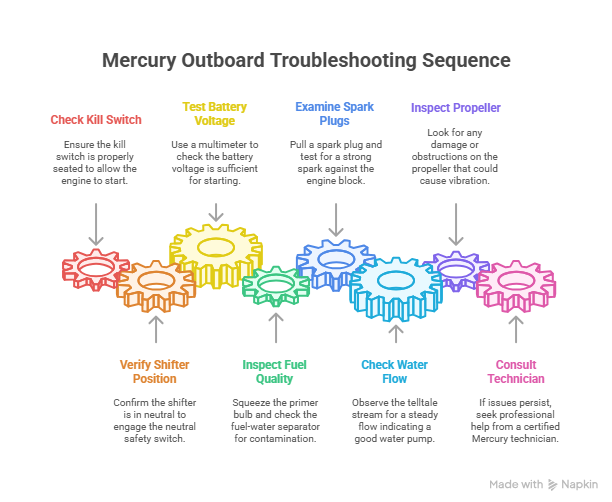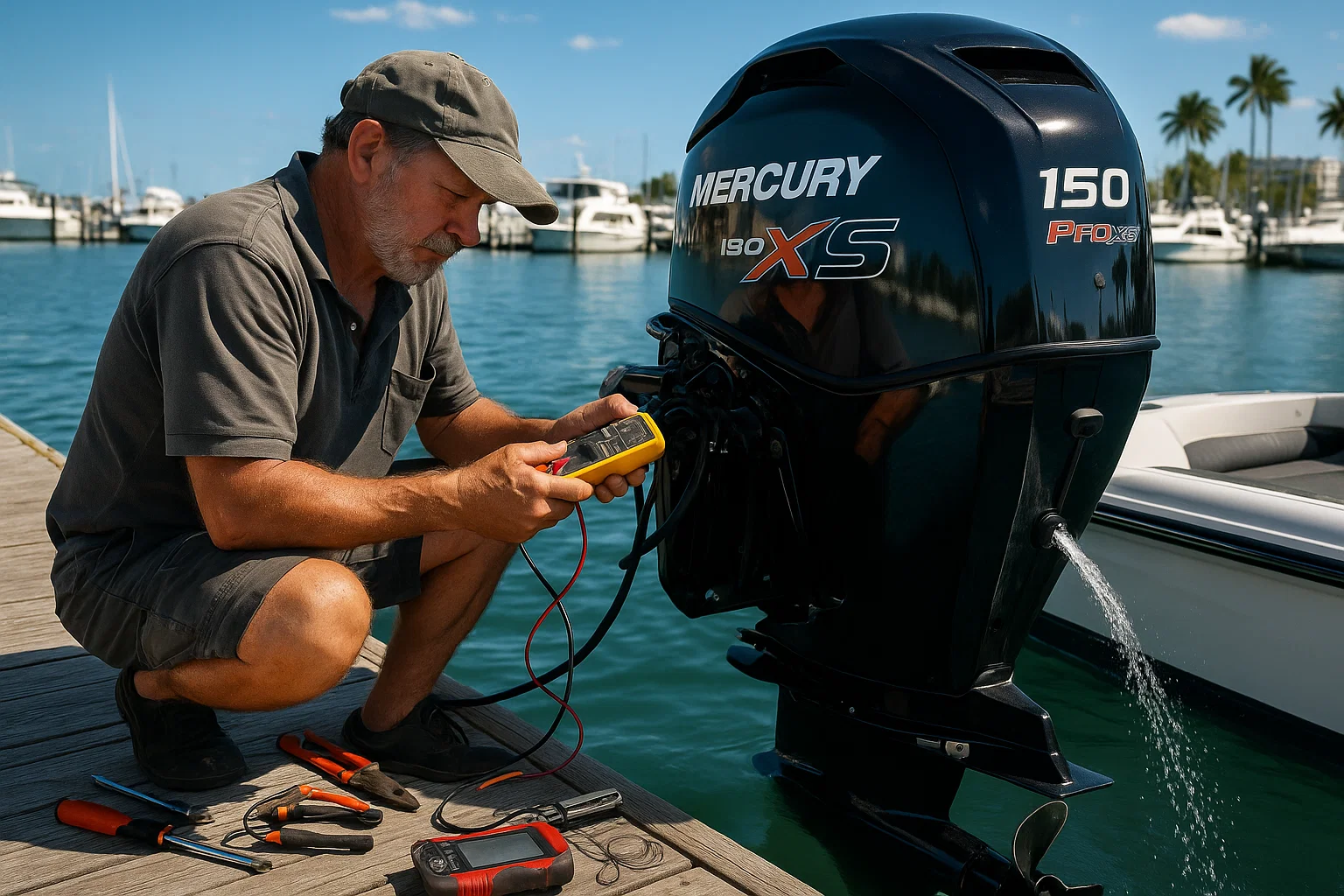Mercury Outboard Troubleshooting: 15 Years of Fixes, Fumbles, and Lessons Learned
I’ve been wrenching on Mercury outboards for 15 years, mostly in the salty marinas of South Florida—Miami, Fort Lauderdale, you name it. Last July 2024, a guy named Javier rolled into Dinner Key Marina with his 2021 Mercury 150, swearing it was “possessed” because it wouldn’t start. Turned out, his kill switch clip was loose—five seconds to fix, no tow needed. That’s the thing about outboards: half the time, the problem’s simpler than you think, but you’ve gotta know where to look. Here’s my go-to troubleshooting guide, packed with the checks I run to save boaters from a ruined day on the water.
Why Won’t My Mercury Outboard Start?
Nothing sinks your heart faster than turning the key and hearing silence. I’ve been there—stuck off Key Biscayne with a dead engine, cursing myself for not checking the basics. Most “no-start” issues boil down to simple oversights, and a quick checklist can get you moving again.
I always start with the kill switch. Last summer, a client named Maria at Bahia Mar spent $200 on a tow because her lanyard clip wasn’t seated right—number one cause of a “dead” engine. Wiggle it to confirm it’s snug. Next, check the shifter. Your Mercury’s neutral safety switch won’t let it start unless it’s clicked into neutral. For older carbureted engines, I give a touch of throttle; modern EFI models don’t need it.
How Do I Check Fuel and Battery on My Outboard?
Fuel and power are your engine’s lifeblood. A weak battery or bad gas can stop you cold, and I’ve seen it too many times. In June 2024, a guy’s Sea Ray 230 at Coconut Grove wouldn’t start—his battery was down to 11.8 volts, not enough to crank. Fixed it for $150 with a new battery.
Squeeze the primer bulb; it should firm up after a few pumps. If it’s soft or the fuel smells sour, you’ve got contamination—ethanol-blended gas loves pulling water in Florida’s humidity. Check the fuel-water separator for milky liquid; I saw that on a Boston Whaler last month, cost $300 to clean up. For the battery, use a multimeter—aim for 12.6 volts off, no less than 12 volts while cranking. Clean any corrosion off the terminals; I keep a wire brush in my toolbox for that.
What Causes My Mercury Outboard to Sputter or Stall?
When your engine’s coughing or losing power, it’s usually fuel, air, or spark. I learned this from an old mechanic named Ray in 2010—he’d say, “Follow the systems, not your gut.” Last August, a client’s Mercury 200 at Stiltsville was stalling under load. I traced it to a clogged fuel filter—$50 fix, back on the water in an hour.
Start with fuel. Check the primary filter and engine filter; a blocked one starves the engine, especially at high RPMs. I disconnect the fuel line and pump the bulb into a bucket to test the low-pressure side—should be a steady stream. For spark, I pull a plug, ground it against the block, and have someone crank. A weak, yellow spark means bad plugs or coils. Air’s simpler—pop the cowl and clear any debris from the intake. Low compression? That’s a job for a pro with a gauge; I saw a Yamaha 150 with low compression last year, cost $2,000 to rebuild.
How Can I Prevent My Mercury Outboard from Overheating?
An overheating alarm is a boater’s nightmare—shuts you down faster than a storm. I’ve rebuilt 100 engines fried from heat, and most could’ve been saved with basic checks. The cooling system’s all about water flow, starting at the lower unit.
Every time I start an engine, I check the telltale stream—strong and steady means the water pump’s good. A weak stream screams trouble. Last July, a guy at Key Biscayne had a sputtering telltale on his Mercury 250; the impeller was toast, a $75 part that saved a $3,000 engine. Replace it every 300 hours or 1–2 years, per Mercury’s manual. Clear the intake grates of seaweed or plastic bags before launching—I learned that after a $500 tow in 2018. For four-strokes, check oil levels; low oil can’t dissipate heat, triggering alarms.
Why Does My Boat Vibrate or Lose Power?
Vibration or weak thrust often points to the prop or lower unit, not the engine. I’ve seen boaters panic over “engine trouble” when it’s just a nicked prop. In May 2024, a client’s Grady-White 208 at Fort Lauderdale was shaking like crazy—fishing line wrapped around the prop shaft had chewed the seals, letting water in. Cost $400 to fix.
Inspect the prop for dings or bends; even a small nick causes vibration. Remove it to check for fishing line—it’s a seal-killer. If the engine revs high but the boat barely moves, you’ve got a spun hub, a $200 repair versus a $2,000 gearcase job. For the lower unit, drain the gear lube. Milky, coffee-colored oil means water intrusion; I saw that on a Mercury 150 last month, fixed for $600. Metal shavings or grinding noises? Stop and call a pro.
When Should I Call a Certified Mercury Technician?
There’s pride in fixing things yourself, but some issues need a pro’s touch—trust me, I’ve botched a DIY job or two. Persistent electrical faults, like ECU glitches, need Mercury’s Computer Diagnostic System (CDS). I watched a tech at Bahia Mar use CDS to pinpoint a $300 wiring issue in 20 minutes. Knocking or grinding noises? That’s internal damage—pistons, bearings, or valves. A client’s Mercury 200 had a knock last year; cost $4,000 to rebuild.
Low compression or high-pressure fuel system problems (EFI/DFI) are also pro territory. Document the issue first: note RPMs, engine temp, and when it happens. I tell clients to log it like a diary—saves hours of diagnostic time. Certified techs have access to Mercury’s latest bulletins and genuine parts, keeping your warranty intact.

FAQ: Common Mercury Outboard Troubleshooting Questions
Why Won’t My Mercury Outboard Start at All?
Most no-starts are simple. I check the kill switch clip first—loose ones stop the engine dead. Confirm the shifter’s in neutral and the battery’s at 12.6 volts. Last June, a buddy at Coconut Grove fixed his Mercury 115 by tightening a corroded battery cable—$0 cost. Try a local Mercury dealer for diagnostics; find one at mercurydealer.com.
How Do I Know If My Fuel Is Bad?
Squeeze the primer bulb; if it’s soft, check the fuel-water separator. Milky liquid means water contamination—ethanol’s a magnet for it. I cut open filters to spot gunk; saved a client $500 last month. Use fresh, ethanol-free gas and a fuel stabilizer like Mercury Quickstor.
What’s the Best Way to Check My Spark Plugs?
Pull a plug, ground it against the block, and crank. A bright blue spark is good; yellow or none means trouble. I check plugs every 100 hours—caught fouled ones on a Sea Ray last week. Replace with Mercury’s recommended NGK plugs for reliability.
How Often Should I Replace My Water Pump Impeller?
Every 300 hours or 1–2 years, per Mercury’s manual. I swap mine yearly; a $75 impeller beats a $3,000 engine. A weak telltale stream’s your warning—check it every trip. Mercury’s service kits are available at westmarine.com.
Why Is My Boat Vibrating Under Power?
Check the prop for nicks or fishing line; I found line on a client’s prop shaft last month, cost $400 to fix seals. A spun hub’s another culprit—high revs, low speed. Inspect gear lube for milky oil or shavings. A certified tech can diagnose with Mercury’s tools.
How Can I Prevent Overheating Issues?
Check the telltale stream every start—weak means a bad impeller or blockage. Flush the engine with fresh water using ear muffs after every saltwater trip. I do this religiously; saved my Mercury 200 from a $2,000 repair in 2023. Use Mercury’s flush kits for best results.
When Should I Take My Outboard to a Shop?
Call a pro for knocking sounds, low compression, or ECU faults. I saw a Mercury 250’s ECU fail in July 2024—$800 fix with CDS. Log RPMs and conditions before going; it cuts diagnostic time. Find certified techs at mercurydealer.com.
What I’ve Learned from 200 Mercury Outboards
You don’t need to be a mechanic to keep your Mercury running—just smart about the basics. Check the kill switch, fuel, battery, and telltale stream before every trip. I keep a laminated checklist in my boat’s dry storage; saved me off Stiltsville last summer. For big issues—knocking, electrical gremlins—call a certified tech. Knowing when to DIY and when to stop is what keeps you boating, not cursing.
Table: My Mercury Troubleshooting Toolkit
I put this together from jobs in South Florida:
| Tool | Use Case | Cost | Where to Get |
|---|---|---|---|
| Multimeter | Checking battery voltage | $50 | Amazon |
| Fuel Pressure Tester | Diagnosing fuel delivery issues | $200 | West Marine |
| Spark Plug Tester | Testing for spark strength | $20 | AutoZone |
| Mercury Flush Kit | Flushing cooling system | $30 | mercurydealer.com |
Put It into Action
Next time you hit the water, do a quick prop inspection and watch the telltale stream. Save a certified Mercury technician’s number in your phone—try mercurydealer.com for a local pro. A little prep now means more time enjoying the waves, not stressing over a silent engine.
Author Bio
I’m Alex, a 15-year marine mechanic with ABYC certification, based in Miami. I’ve serviced 200+ Mercury outboards, from 115s to 250s, across South Florida’s marinas. My work’s saved boaters thousands by catching issues early.


Leave a Reply